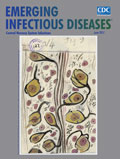
Volume 23, Number 6—June 2017
Etymologia
Etymologia: Creutzfeldt-Jakob Disease

Figure. (L–R) Hans Gerhard Creutzfeldt (1885–1964; Alfons Maria Jakob (1884–1931); Creutzfeldt–Jakob disease, cerebrum hematoxylin and eosin staining showing spongiform encephalophathy. Images reproduced from Foundations of Virology, 2012, courtesy Frederick A. Murphy.
In 1920, German neuropathologist Alfons Maria Jakob (Figure) described a series of 6 patients with spasticity and progressive dementia associated with neural degeneration. Shortly thereafter, in 1921, another German neuropathologist, Hans Gerhardt Creutzfeldt (Figure), independently published a similar case. Jakob gave credit to Creutzfeldt for describing the syndrome first, without realizing he had also uncovered the new syndrome. Walther Spielmeyer first used the term “Creutzfeldt-Jakob disease” (CJD) in 1922. CJD occurs worldwide as a rare, sporadic disease, with genetic and iatrogenic forms (Figure). A zoonotic form, variant CJD (vCJD), is caused by infection with a prion derived from bovines and occurs predominantly in the United Kingdom.
This issue of Emerging Infectious Diseases’ long-running Etymologia series is dedicated to the memory of Richard T. Johnson, MD (1931–2015), the leading prion disease authority in the United States for many years and great friend of CDC’s infectious disease programs, so many of which involve central nervous system disorders.
References
- Brown P, Brandel JP, Sato T, Nakamura Y, MacKenzie J, Will RG, et al. Iatrogenic Creutzfeldt-Jakob disease, final assessment. Emerg Infect Dis. 2012;18:901–7. DOIPubMed
- Murphy FA. The foundations of virology: discoverers and discoveries, inventors and inventions, developers and technologies. West Conshohocken (PA): Infinity Publishing; 2012.
- Prusiner SB. Prions. Proc Natl Acad Sci U S A. 1998;95:13363–83. DOIPubMed
- Richardson EP Jr, Masters CL. The nosology of Creutzfeldt-Jakob disease and conditions related to the accumulation of PrPCJD in the nervous system. Brain Pathol. 1995;5:33–41. DOIPubMed






















.png)











No hay comentarios:
Publicar un comentario